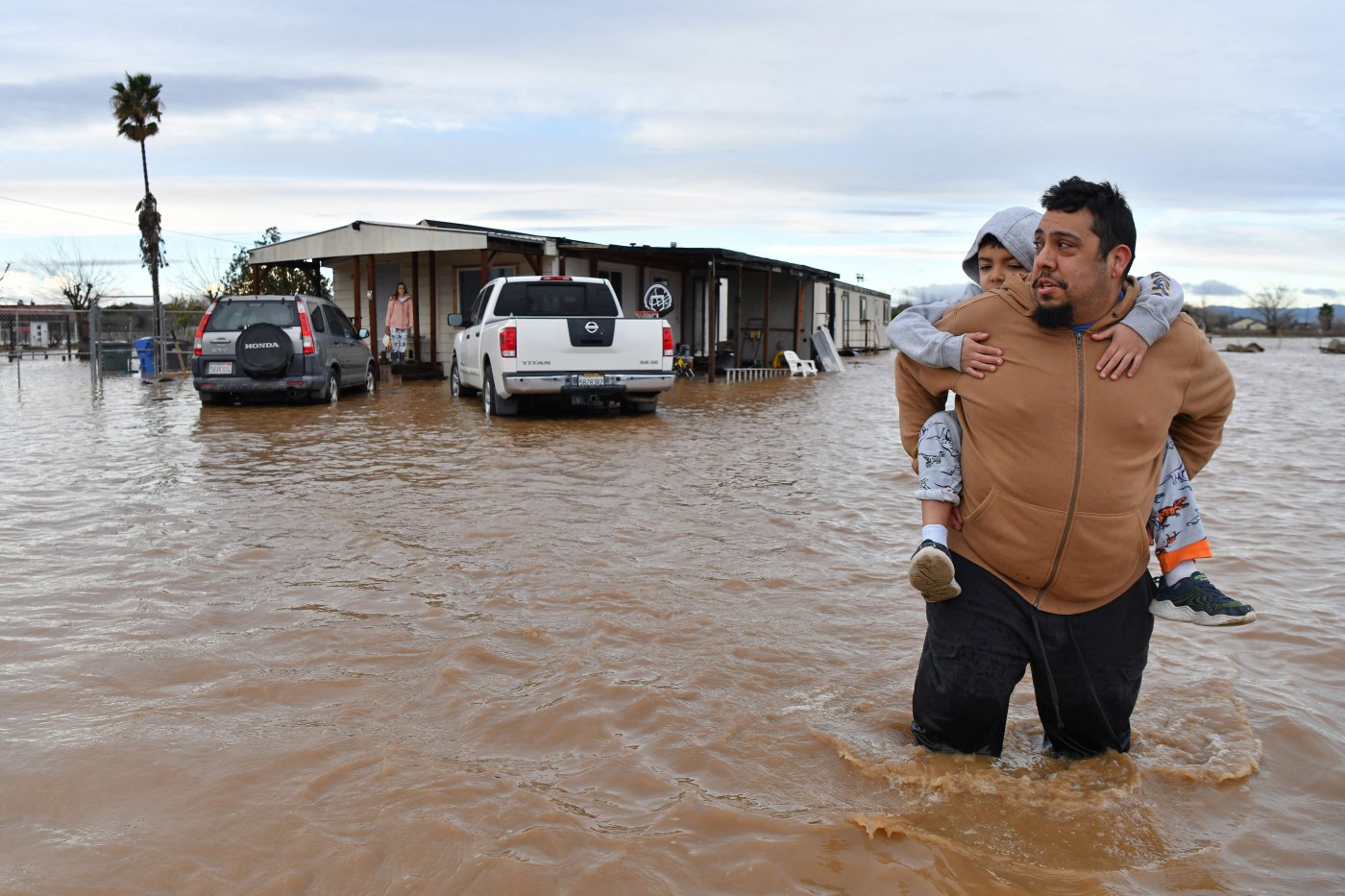MARTINEZ – Across the Bay Area, county officials responsible for emergency planning are bracing for the economic aftershocks should President Donald Trump make good on promises to eliminate the Federal Emergency Management Agency and scrap federal funding that has long helped residents recover from floods, earthquakes and other calamities.
FEMA already has stopped boots-on-the-ground response operations, slashed the list of reimbursable public projects and throttled disaster reimbursements for repairs following natural disasters, extreme weather or other emergencies — just a handful of the changes flagged by Rick Kovar, Contra Costa County’s emergency services manager.
In a push to “wean” states off FEMA, the Trump administration has also reduced federal cost-sharing, paused applications for emergency management grants and ignored prior approvals for dozens of hazard-mitigation projects, including four in California worth more than $125 million for flood prevention.
“It’s important to make sure that everyone understands that these are scary times for us in emergency management,” Kovar said during a multi-agency policy board meeting last month. Until FEMA’s fate is better known, he said “we’re definitely reading the tea leaves.”
There’s a lot at stake for the region. On a FEMA color-coded hazard map, Alameda, Santa Clara and Contra Costa counties are shaded dark red, indicating an area with nearly 4.7 million Californians that face the most dire risks of extreme weather. Of the 10 California counties most at risk, Alameda ranked 4th, Santa Clara ranked 5th and Contra Costa ranked 8th.
For nearly half a century, FEMA has stepped in when the lights have gone out, such as when atmospheric rivers pummeled California in winter 2023, or during the recurrent flooding that threatens single-family homes and creekside encampments across the South Bay.
Contra Costa County Office of Emergency Services Manager Rick Kovar during a meeting of the Emergency Services Policy Board at the Contra Costa County Sheriff’s Department in Martinez, Calif., on Tuesday, Oct. 2, 2024. (Jane Tyska/Bay Area News Group)
Under a federal policy change proposed in April, for example, 75% of the disasters declared across the nation between 2008 and 2024 would not have qualified for FEMA funding that totaled $41 billion, Kovar said.
California would not have secured 26% of the $7.4 billion it received under that scenario, nearly $2 billion lost, according to a May report from the Urban Institute. Only New York would have fared worse.
County emergency planners have taken notice. Contra Costa, for one, lacks the capacity to fill the federal funding gaps if FEMA follows through on proposed rollbacks, Kovar said.
“We’re going to have to really start strategically planning on how we’re going to make that up if we want to stay in the ’disaster recovery game,” said Kovar said, whose team logged 300 hours of unpaid overtime following the “bomb cyclone” in January of 2023. “We don’t want to be in a ‘wait and see’ period with wildfire season coming up.”
Related Articles
29 survivors found after ferry sinks off Bali, Indonesia
Lake Tahoe boating tragedy: Two survivors wore life jackets
Victims identified in Lake Tahoe boating tragedy include DoorDash exec Josh Pickles
Lake Tahoe boating tragedy: Big waves, cold water, strong winds created deadly conditions
Following days-long search, bodies of three Northern California drowning victims found
Inadequate staffing was one of the most glaring concerns identified in a June 2024 civil grand jury report regarding the county’s community warning system, which is designed, maintained and operated by the Sheriff’s Office. In November, the Board of Supervisors authorized $500,000 of Measure X funding to study its current function and explore ways the county can improve its management of emergencies.
Leaders in Santa Clara County, by comparison, are more confident they are equipped with a robust plan when — not if — the next disaster strikes.
The work of “saving lives is not going to be affected if FEMA does or does not reimburse us,” said Charles Harris, spokesperson for the county’s Office of Emergency Management, citing years of investment that established accessible community alerts, periodic reviews of hazard-specific plans and other mitigation policies.
But Santa Clara County Executive James Williams acknowledged this week that even the strongest, most agile emergency management systems are still in jeopardy if FEMA is dismantled.
In 2020 during the COVID pandemic, medical staff work at a new COVID-19 test site at the Santa Clara County Fairgrounds in San Jose. Santa Clara County opened a large-scale coronavirus testing site to test thousands of residents daily. (Dai Sugano/Bay Area News Group)
Consider the pandemic. The enhanced, large-scale crisis response that organized testing sites, vaccination clinics and other public programs within weeks of the Bay Area’s March 2020 public health emergency declaration were fueled by assurance that FEMA would step up when local governments exceeded their means, Williams said.
“The federal government is the only entity that has the ability — on a short term basis — to tap into essentially an unlimited fiscal resource,” Williams said. “But we also should not be fooled into thinking that there is an actual substitute for an effective, robust and committed federal government.”
Without the agency guiding local leaders during emergencies — acting as the infrastructural backbone connecting a nationwide network of specialized resources such as weather forecasts and mutual aid requests — emergency leaders in California will need to come to each other’s aid.
“The architecture behind emergency response is managed by FEMA — its training materials, organization and coordination — and that will degrade,” Williams said. “The notion that the federal government, in today’s day and age, is going to step back and not have a dedicated agency to emergency management and response is really scary and really disturbing.”
Flood waters cover most of Pjaro Valley on Sunday, March 12, 2023 after an atmospheric river storm caused the a break in the levee along the Pjaro river inundating homes and businesses and leaving thousands of people without shelter. (Shae Hammond/Bay Area News Group)
Residents of Pajaro, a small farming town in Monterey County, have already been swept up into FEMA-related funding clawbacks – two years after the community was catastrophically flooded after a 75-year-old levee crumbled following torrential rainfall, which forced thousands to evacuate and damaged over 200 homes.
U.S. Rep. Zoe Lofgren is one of a dozen California representatives to Congress who criticized Trump’s budget request for the next fiscal year, which excluded the Pajaro River Project from the Army Corp. of Engineer’s work plan for 2025. If funding isn’t restored, she and other lawmakers fear the project will be abandoned, half-finished.
Lofgren said in June that ensuring its completion is “vital for the area’s safety and livelihood.”
After torrential rainfall in early 2023 triggered the worst flooding, landslides and mudslides reported in Contra Costa County in recent memory, Tim Ewell, chief assistant county administrator, said a team of 30 federal inspectors were dispatched to help residents and government officials assess the damage — setting up a FEMA trailer in the parking lot outside the former Danville city hall and going door-to-door.
“All of that — under the current administration — is ceasing for individual assistance claims,” Ewell told the county board in late June. While the money set aside to reimburse local governments’ taxpayer-funded disaster work has not been cut from the federal budget, “right now, they’re not funding it.”
“What that means is we need to become more resilient as a county and as a state,” Ewell said.





